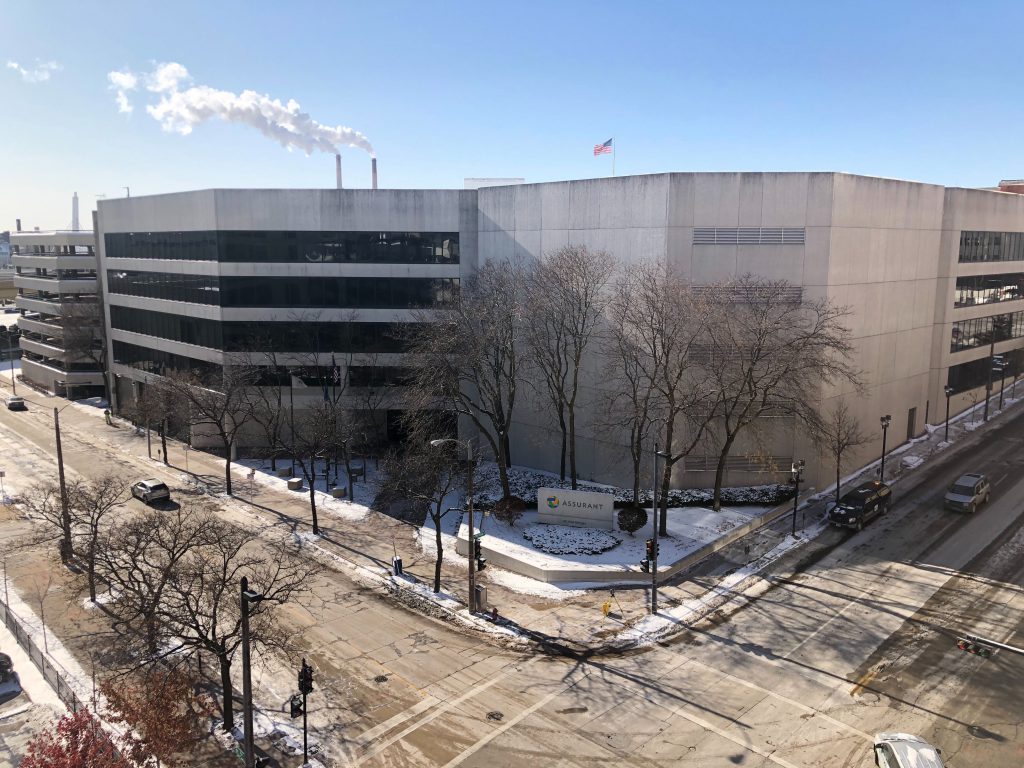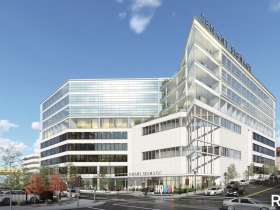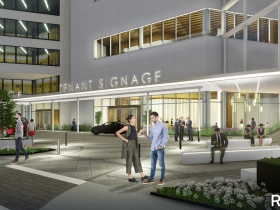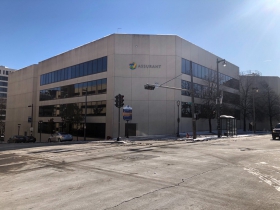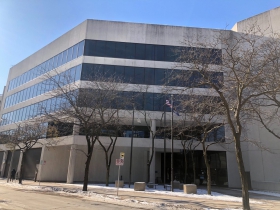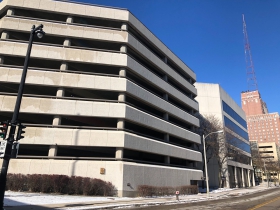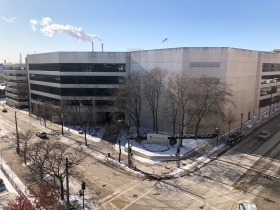How The Milwaukee Tool Deal Works
Yes, it's $20 million in city cash for 2,000 downtown jobs, but that barely begins to describe the complex agreement.
It was big news seemingly out of nowhere. A public meeting notice revealed that Milwaukee Tool could bring up to 2,000 jobs to Downtown. The proposal signaled several things: the strength of the downtown Milwaukee market, the expectation that employers will bring employees back to office buildings and the big growth plans of a Milwaukee area employer.
But if Milwaukee Tool does go forward with the plan, it’s more complicated than opening up shop and getting cash from the City of Milwaukee. There are hiring counts to reach, investment targets to satisfy, clawbacks that could be invoked and a pandemic-inspired allowance for employees who end up working remotely. There is also the potential of adding four floors to the top of the five-story building.
The proposal calls for the City of Milwaukee to give the company a $12.1 million grant in exchange for bringing 1,210 jobs to the city by 2026 and investing $30 million in a new facility.
Milwaukee Tool would buy the vacant HQ501 building, 501 W. Michigan St., from developer Scott Lurie. The building, constructed in 1978, has been vacant since Assurant Health left in 2016. Lurie acquired the property, including its 850-stall parking structure, in 2019 with plans to land an anchor tenant. The development term sheet says the building has approximately 300,000 square feet of usable space.
Including the building purchase, the company would need to spend at least $15 million on the property by the end of 2022. And invest another $15 million by the end of 2024. Upon meeting the $30 million target, the city would release the $12.1 million grant.
The employment target would grow over time to 650, then 800, 950, 1,100 and finally 1,210 employees in year six. If Milwaukee Tool doesn’t reach the target in a given year, it would need to refund the city $10,000 per employee it is short. If it falls short in consecutive years, Milwaukee Tool would only need to refund the growth in the shortage (i.e. falling short by 50 employees in year two would cost $500,000, and 100 in year three only an additional $500,000, not $1 million).
A new, pandemic-related provision is also included. Employees that work entirely remotely can count as eligible employees, but only if they live in the City of Milwaukee. This opens up a potential loophole where the company could move employees at its Brookfield or Menomonee Falls facilities that live in the city to work from home to meet the target. But the term sheet also has an anti-suburban clause related to remote work. Partially-remote workers would need to spend at least 60% of their time working at the new facility or in their city residence. A Brookfield resident that comes into work two days a week would not count as a full-time employee.
The city would recover costs associated with the grant through increased property tax revenue from the development. The property is currently assessed for $4 million. The tax incremental financing (TIF) plan to fund the entire deal includes an economic feasibility study that calls for the property to be assessed for at least $45 million in 2024. With a contemplated expansion, it is estimated to be valued at $92 million in 2048.
But the structure of that additional funding is far more complicated than the initial grant. Milwaukee Tool would get $10,000 per employee in excess of the initial 1,210 on an annual basis if the incremental property tax revenue from the development can cover the cost and if the company adds at least three floors and 150,000 square feet of space to the building. A 2019 plan from architecture firm RINKA, marketed by Lurie, showed four new floors, a rooftop deck, new signage and a host of other improvements being made to the building.
If the company completes the expansion and exceeds the employment threshold, the city would grant the company up to $7.9 million plus 4.5% interest.
The structure is similar to other developer-financed TIF deals the city has created, which place the risk on the company.
But unlike those deals, including the Komatsu Mining campus, Strauss Brands proposal and MilliporeSigma relocation, this TIF district would include the initial grant and the complications with satisfying those obligations first.
Payments to Milwaukee Tool could exceed the $7.9 million cap if the company initially misses projections and has to repay a portion of its $12.1 million grant. The city would allocate 75% of those repaid funds as part of a potential future payout if the employment total would exceed projections in the future.
The term sheet does not specify a timeline for when Milwaukee Tool would complete the expansion, but no interest is to be added until the expansion is completed.
An economic feasibility estimate concludes that with no building expansion the costs would be recovered after 18 years. If the expansion occurs, and an additional 790 employees are hired, the recovery would take 19 years. The projection shows that if all goes according to plan, the city would have more than $20 million in incremental revenue it could spend on nearby projects in the 2040s before it wound down the district.
Debt costs associated with the initial grant, estimated at $10.4 million, would be recovered via the increased property tax revenue. It is included in the payback projections.
The increased value of the property would be included in the city’s property tax calculations after the district’s closure, a move that would reduce the property tax rate all else being equal. The amount the city can collect via the property tax levy is capped under state law.
In exchange for the grants, Milwaukee Tool has a series of other obligations. It must continue to “support opportunities” for Milwaukee high school students to train for careers with the company or in fields that utilize Milwaukee Tool products.
More significant, Milwaukee Tool must have 40% of the work hours performed on the building’s redevelopment be performed by unemployed or underemployed city residents through the Residents Preference Program. At least 25% of the construction costs and 18% of the professional services (architecture, engineering, etc, etc) costs must go to city-certified Small Business Enterprises. Those amounts are required terms for all TIF districts where the city is awarding $1 million or more.
Where will all these new jobs come from? According to a tweet from Metropolitan Milwaukee Association of Commerce president Tim Sheehy, they are new jobs, not relocations from elsewhere in the region.
In the past decade Milwaukee Tool repeatedly expanded its Brookfield headquarters, adding more than 300,000 square feet of space.
According to a 2019 Wisconsin Economic Development Corporation release, since 2016 the company has pledged to create up to 1,812 new jobs and invest $174.5 million in capital projects in exchange for up to $46 million in tax incentives. That includes new or expanded plants in Sun Praire and West Bend.
Founded in Milwaukee in 1924, Milwaukee Tool is now a subsidiary of Hong Kong-based Techtronics Industries. The company moved to Brookfield in 1965. It produces cordless power tools, lighting fixtures, accessories, hand tools and storage items.
The city’s Redevelopment Authority will first consider the proposal at its April 15th meeting. The tax incremental financing proposal is subject to Common Council approval.
A full copy of the TIF district project plan, including the term sheet, can be found on Urban Milwaukee.
Renderings
Photos
If you think stories like this are important, become a member of Urban Milwaukee and help support real, independent journalism. Plus you get some cool added benefits.
More about the Milwaukee Tool expansion
- Friday Photos: Milwaukee Tool Paints Downtown Red - Jeramey Jannene - Jun 16th, 2023
- Friday Photos: Milwaukee Tool Readying Downtown Office - Jeramey Jannene - Oct 22nd, 2021
- Eyes on Milwaukee: Downtown Office Building Sold to Milwaukee Tool - Jeramey Jannene - May 24th, 2021
- Eyes on Milwaukee: Council Okays $20 Million Milwaukee Tool Deal - Jeramey Jannene - May 4th, 2021
- Eyes on Milwaukee: Council Committee Amends Milwaukee Tool Deal - Jeramey Jannene - Apr 27th, 2021
- Eyes on Milwaukee: Barrett Pushes Council To Accept Milwaukee Tool Deal - Jeramey Jannene - Apr 24th, 2021
- Eyes on Milwaukee: Milwaukee Tool Deal Gets First Approval - Jeramey Jannene - Apr 15th, 2021
- Eyes on Milwaukee: How The Milwaukee Tool Deal Works - Jeramey Jannene - Apr 6th, 2021
- Eyes on Milwaukee: Milwaukee Tool Could Bring 2,000 Jobs Downtown - Jeramey Jannene - Mar 31st, 2021
- Plats and Parcels: Meet HQ501 - Jeramey Jannene - Dec 21st, 2019
Read more about Milwaukee Tool expansion here
Eyes on Milwaukee
-
Church, Cupid Partner On Affordable Housing
 Dec 4th, 2023 by Jeramey Jannene
Dec 4th, 2023 by Jeramey Jannene
-
Downtown Building Sells For Nearly Twice Its Assessed Value
 Nov 12th, 2023 by Jeramey Jannene
Nov 12th, 2023 by Jeramey Jannene
-
Immigration Office Moving To 310W Building
 Oct 25th, 2023 by Jeramey Jannene
Oct 25th, 2023 by Jeramey Jannene


